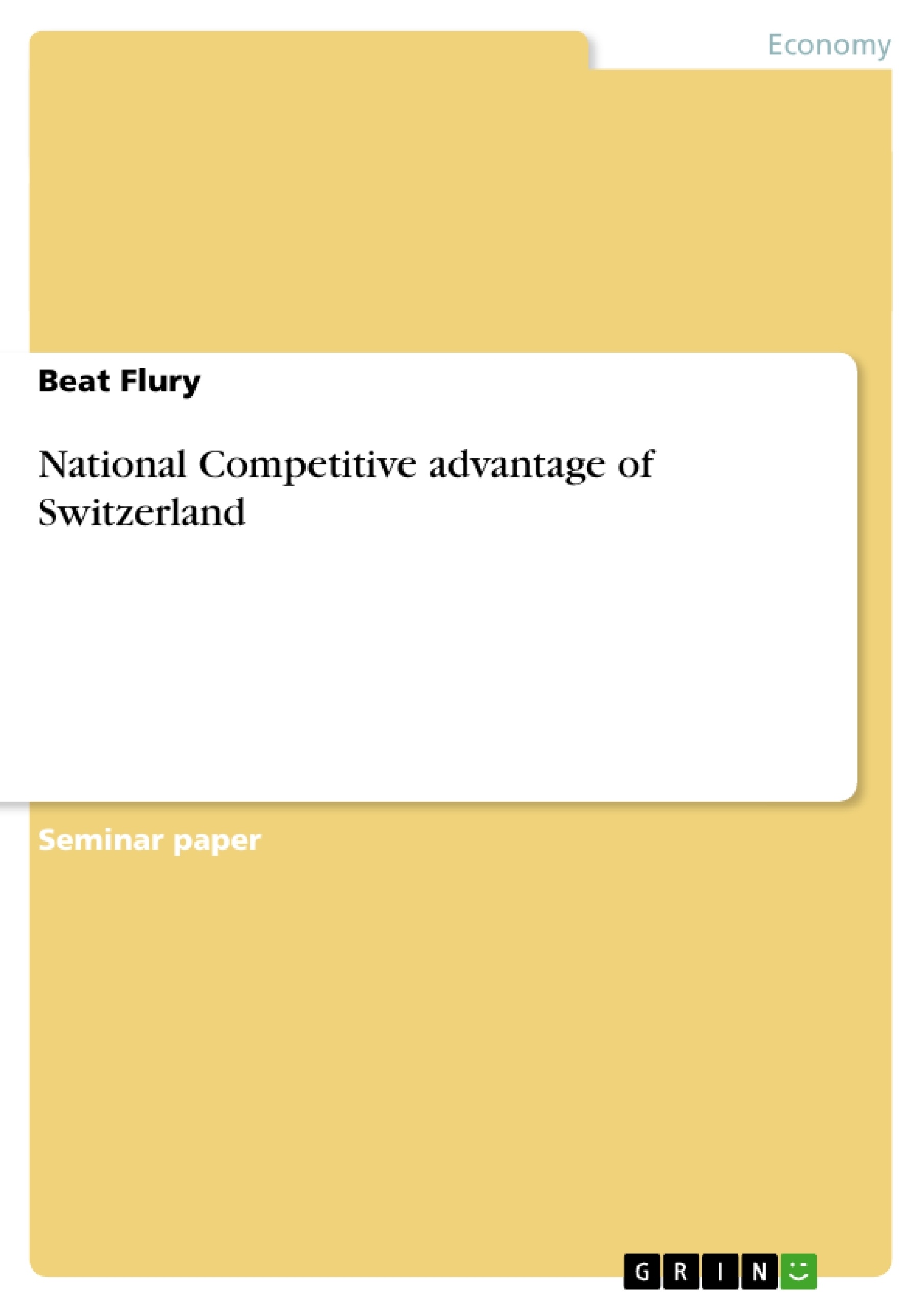Excerpt
Table of Content
Introduction
Determinants of National Advantage
Factor Conditions:
Demand Conditions:
Related and Supporting Industries:
Firm Strategy, Structure and Rivalry:
Patterns of Swiss Competitive Advantage in 1985:
Clusters of Internationally competitive industries in 1985:
Factor Conditions:
Demand Conditions:
Related and supporting industries:
Firm Strategy, Structure and Rivalry:
Conclusion:
Switzerland during the 1990ies:
Factor Conditions:
Location:
Low Taxes:
The R&D spending:
High saving rate/strong currency/low interest rates:
Demand conditions:
Strong home demand:
Related and supporting industries:
Firm Strategy Structure and Rivalry:
Two or more competitors in a successful industry:
Enhancement of Porters Model:
Government:
Change:
Switzerland a Wealth driven economy?
Conclusion:
Outlook - is Switzerland becoming more competitive again?
Figures:
Bibliography:
Introduction
Switzerland has been a poor nation as late as the nineteenth century. Its major exports were mercenaries and emigrating citizens (Porter 1998, 307). In the early decades of the 20th century, Switzerland has emerged as an industrial nation of importance. Because Switzerland avoided destruction during World War II the country was an early winner. The circumstances made them well positioned to prosper in early post war periods. By the 1960’s, using some measures, Swiss per capita income was the highest in the world (Porter 1998, 307). Industrial success was enough to more than employ all available Swiss citizens at high wages. Total unemployment was in the 60ies 0.0% (Porter 1998, 281) Swiss companies like Nestlé, Novartis, UBS, Roche, Schindler, Swatch Group or Lindt and Sprüngli, are global operating. The leading Swiss multinationals employ far more people outside the country than in Switzerland (Porter 1998, 307). Switzerland is an example how a small nation without a large home market can be a successful global competitor.
At the moment Switzerland is still a prosperous country but it lost economic wealth. During the 1990ies Switzerland had the lowest growth rates compared to all OECD member states. This working paper tries to answer the question if Switzerland lost competitive advantage, and if the low growth rates are a result out of this. In the first part of the text Porters theory of national advantage is explained the second part reflects the state of the Swiss economy in the late 1980ies and the third part analyzes what has happened in Switzerland from 1990 to 2000.
Determinants of National Advantage
Porter (1998, 72) used a diamond shaped diagram as the basis of a framework to illustrate the determinants of national advantage. This diamond represents the national playing field that countries establish for their industries. The determinants of national advantage are:
- factor conditions
- demand conditions
- firm strategy, structure and rivalry
- related and supporting industries
Factor Conditions:
Each nation has some factors of production to compete within an industry, such as labour, natural resources, capital and infrastructure. To explore the factors in competitive advantage of a nation, factors can be grouped into a number of broad categories:
- Human resources
- Physical resources
- Knowledge resources
- Capital resources
- Infrastructure
Demand Conditions:
When the market for a particular product is larger locally than in foreign markets, the local firms devote more attention to that product than do foreign firms, leading to a competitive advantage when the local firms begin exporting the product. A more demanding local market leads to national advantage.
Related and Supporting Industries:
When local supporting industries are competitive, firms enjoy more cost effective and innovative inputs. This effect is strengthened when the suppliers themselves are strong global competitors.
Firm Strategy, Structure and Rivalry:
Local conditions affect firm strategy. For example, German companies tend to be hierarchical. Italian companies tend to be smaller and are run more like extended families. Such strategy and structure helps to determine in which types of industries a nation's firms will succeed.
Patterns of Swiss Competitive Advantage in 1985:
Clusters of Internationally competitive industries in 1985:
After Porter (1998, 316) in the following sectors Swiss international competitive advantage is situated: Petroleum/Chemicals, Multiple Business, Textiles/Apparel and Health Care. In Porters opinion is the range of industries in which Switzerland had a leading position extraordinary. The number and breadth of the clusters exceeded the ones from other comparable small nations like Sweden, Denmark or Singapore. One of the most important Clusters was health care related industries. Another important cluster was a group of industries related to textiles, followed by internationally orientated business services (table 1). Switzerland's position in these industries tends to be very specialized and focused on the most sophisticated segments. Compared to other countries Switzerland's position is very strong in marketing and service intensive goods.
Abbildung in dieser Leseprobe nicht enthalten
Table 1: Important Clusters in Switzerland (Porter 1998, 317)
Switzerland had a weak position in forest products, semiconductors, and computers, telecommunications, entertainment and leisure (except tourism) and defence.
[...]
- Quote paper
- Beat Flury (Author), 2002, National Competitive advantage of Switzerland, Munich, GRIN Verlag, https://www.grin.com/document/9603
Publish now - it's free






















Comments